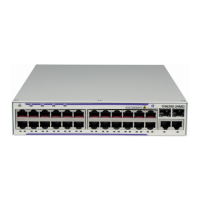Circuit Emulation (Cpipe) Services
Page 126 7210 SAS M Services Guide
Circuit Emulation Parameters and Options
All ports on the T1/E1 ASAP Adapter card can be configured independently to support TDM
circuit emulation across the packet network. Structure-aware mode (CESoPSN) is supported for n
× 64 kb/s channel groups in DS1 and E1 circuits. Unstructured mode (SAToP) is supported for full
DS1 and E1 circuits. The following parameters and options are described in this section:
•Unstructured
• Structured DS1/E1 CES without CAS
• Structured T1/E1 CES with CAS
• Packet Payload Size
• Jitter Buffer
• RTP Header
• Control Word
Unstructured
Unstructured CES is configured by choosing satop-t1 or satop-e1 as the vc-type when creating a
Cpipe service. For DS1 and E1 unstructured circuit emulation, the framing parameter of the port
must be set to ds1-unframed and e1-unframed (respectively) because SAToP service ignores the
underlying framing. Additionally, channel group 1 must contain all 24 or 32 timeslots, which is
configured automatically when channel group 1 is created.
For DS1 and E1 circuit emulation, the payload packet size is configurable and must be an integer
value between 64 and 1514 octets and must be a multiple of 32. The payload packet size affects the
packet efficiency and packetization delay. Table 8 shows the default values for packet size and
packetization delay.
Note: When using SAToP to transport DS1 traffic, the framing bit (bit 193) in the DS1 overhead is
included and packed in the payload and sent over the PSN. If the underlying framing is ESF, then
the Facility Data Link (FDL) channel is transported over the Cpipe as part of the SAToP service.
No matter the case, the framing parameter of the port must be set to unframed.
Table 8: Unstructured Payload Defaults
Circuit Payload Size (Octets) Packetization Delay (milliseconds)
DS1 192 1.00
E1 256 1.00

